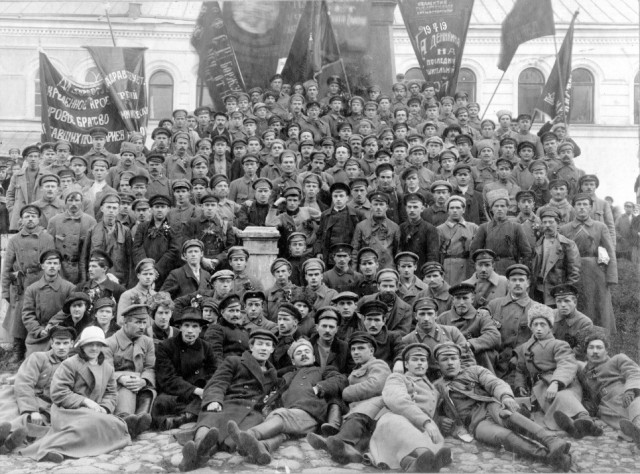Alex Grant from the Canadian section of the International Marxist Tendency debunks the top 10 slanders about the October Revolution, starting with lies one through five.
No other event in human history has been the subject of more distortions, falsehoods, fabrications, and downright lies as the Russian Revolution. Those witnessing the treatment of Jeremy Corbyn by the British press have got a flavour of the bile and spite of the establishment. Hugo Chavez and the Venezuelan Revolution have also received such special attention in the recent period. But nothing is so deserving of the hatred of the ruling class as the Bolshevik Revolution of 1917, because only here did the slaves completely overthrow the old order and begin to build a new society without need for lord or master.
The reason for such calumny against the Bolsheviks is plain to see. This event, more than any other, shows that there is another way to run society. That workers and youth, the poor and oppressed, do not have to submit to the diktats of the ‘men in suits’ who profit from their suffering. Countless hours, and billions of dollars, pounds, and euros, have been and are being expended to convince people that nothing good came of the Russian Revolution and there is nothing to be learnt from it for our struggles today. An entire army of so-called ‘experts’ has been mobilized for this special task of maintaining the status-quo.
Watch Alex deliver a talk on the top ten lies about the Bolshevik Revolution at the 2017 IMT World School in Bardonecchia:
On the centenary of 1917, when the world finds itself in a similar impasse, this slander is again reaching a new crescendo.
The volume of falsehoods against the revolution has been truly immense ever since the Soviet workers seized power. Trotsky commented on how “the slanders poured down like Niagara”. The Western press was filled with stories of murder and mayhem from day one. For example, it was claimed that the Petrograd “Bolsheviki” were in possession of “an electrically operated guillotine that lopped off five hundred heads per hour”, and that in Soviet Russia all women over the age of 18 were required to register with the “Bureau of Free Love”, where cultured bourgeois women would be parcelled out to various proletarian husbands on a rotational basis. (Reported in The Bolshevik Revolution by Philip S Foner). Other horrors were described, such as wealthy women being forced to do cleaning, and high-rank businessmen compelled to sell newspapers on street corners in order to survive – oh the humanity!
Lenin was fond of the saying that “one fool can ask ten times more questions than ten wise men can answer.” There is no way that all the lies about the revolution can be answered in a single article, but we are aided by a phenomenon that Trotsky detailed in his History of the Russian Revolution, where he explained why all political slander is essentially “poor and monotonous”. In this regard we can identify the top 10 most monotonous lies about the Bolshevik Revolution in order to arm the reader with the truth that can cut through the distortion and malice. This is an unenviable but necessary task, cleaning out the muck and filth of 100 years: but hopefully the reader will find this useful.
1) Lenin was a German agent!
This is the first and the oldest of the lies against the Bolsheviks. It was the main lie propagated during the July days of reaction where the Bolsheviks were illegalized, Lenin was forced into hiding, and Trotsky was imprisoned. The wave of reaction let loose by this lie led to the Bolshevik printing presses being smashed and even some rank-and-file paper sellers and posterers being beaten and murdered. After a few weeks of being fooled the Russian workers and peasants saw through the fabrication and began to massively turn against those perpetuating this lie as a pretext to continue the bloody world war and the rule of the rich and the landowners. Bolshevik support in the country progressively increased from mid-August onwards.
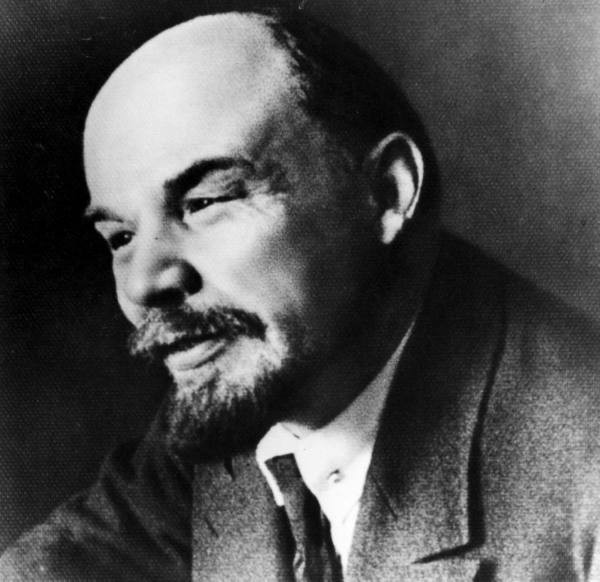
However, the fact that the Russian people saw through this lie 100 years ago has not stopped it from being repeated and re-hashed even up to the present day. On 19 June 2017, practically 100 years to the day after this lie was first concocted, The New York Times published an article repeating it word-for-word. We should commend The Times for their environmentalism, as they are clearly very committed to recycling!
The lie goes something like this. After the February revolution Lenin travelled to Russia via Germany in a “sealed train”. On the way he received funds from the Kaiser and actively worked to sabotage the Allied war effort under the direction of the Germans. But what is the truth?
Yes, Lenin was forced to travel via Germany to Finland in order to reach revolutionary Russia. Lenin was well aware of the political risk he was taking by travelling through Germany, and that is why he insisted on the train being ‘sealed’, with nobody coming on or off for the duration of the trip. But what was his alternative? The Allied powers, French and British imperialism, refused to allow him safe passage over their occupied territory. When Trotsky attempted to reach Russia from New York via steamliner, British secret services had him arrested for a month in Halifax, Canada and only mass protests forced his release. We are sure that the imperialists would have been very happy for Lenin to remain isolated in Switzerland, but that wasn’t really an option.
These slanderers also conveniently forget that Martov, many other Mensheviks, and others in exile, were also forced to take the German route back to Russia. And yet none of these are accused of being German agents as that is not politically convenient.
What of the German gold Lenin was supposed to have received from the Kaiser? To date, despite searching high and low, nobody has been able to find a trace of its existence and all the innuendos have been debunked. If Pravda was receiving foreign sponsorship, it certainly did not look like it. It was smaller and was distributed in far lower numbers at the trenches than the papers of the Liberals and reformists (which genuinely had rich backers).
The New York Times reports that Russian workers were paid ten rubles to hold a Bolshevik placard. However, in 1921 Kadet leader Miliukov reported the going rate was fifteen rubles. Clearly The Times is the place to find a good bargain! And yet no paper trail has been found for these illicit payments that were able to rouse millions on the streets to face down the rifles and whip of police and Cossacks. Nobody has been able to trace the distribution network to get this money to all parts of the Tsarist empire that elected Bolshevik deputies.
The allegation of foreign funding occurs in every mass movement from time immemorial. Such ‘fake news’ was even reported in the protests against Donald Trump’s inauguration who were supposedly paid $3500 a head from a fund set up by Jewish liberal billionaire, George Soros. Trump himself got in on the act and tweeted about “professional protesters”. This tale is reminiscent of Wagner’s opera Das Rhinegold which tells the tale of magical gold that will make the bearer all-powerful. The deposed ruling-class cannot conceive of why the mass population would reject them, and therefore turn to fairytales of otherworldly riches. The reality is much more mundane: Lenin and the Bolsheviks proposed ideas that the population supported. This was the source of their ‘magical’ power.
Of course the German imperialists had their own plans for allowing a train full of radicals and ‘pacifists’ to travel across their territory. They gambled that the dissidents would cause dislocation and weaken the Russian war effort, but they never in their wildest dreams imagined that the Bolsheviks would come to power. Such maneuvers are not unique to German imperialism. However, this particular gamble by the German general staff clearly backfired as events have shown.
On the night of 29 October 1918, a mutiny broke out in the German fleet. Inspired by the Russian Revolution, workers’ councils seized most coastal cities by 7 November. Kaiser Wilhelm II was forced to resign on 9 November. By 11 November the German workers, following the lead of their Russian brothers and sisters, defeated German imperialism and brought an end to WWI by revolutionary means. In this sense it can be said that not only was Lenin not a German agent, but he was the instigator of the downfall of the Kaiser.
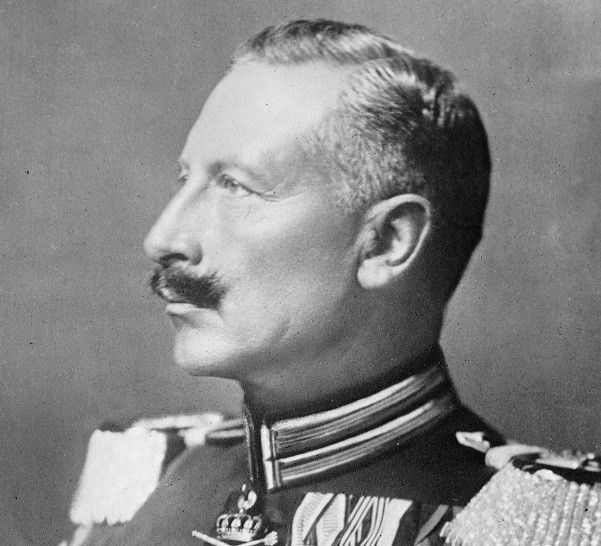
Conversely, it was the Russian Provisional Government and general staff that were the true German agents. Even the Tsar and Tsarina were plotting for a separate peace with Germany prior to the February Revolution. In August, the Russian generals allowed the fall of Riga to the Germans to provide a pretext for the Kornilov coup and to teach the Riga Soviet a lesson at the end of a Prussian bayonet. Similarly, with power slipping through his fingers, Kerensky planned to move the Petrograd garrison to the front and surrender the capital to allow the Germans to massacre the revolutionary workers.
This was the last act that convinced the mass of the soldiers that the Provisional Government was not worthy of their support. The Petrograd garrison disobeyed the criminal order to abandon Petrograd, and instead changed their allegiance to the Soviet.
Here we can see that in the last analysis, for the bourgeois, class always trumps nation. The Russian ruling class preferred to give away its capital city to a foreign power rather than have it fall into the hands of the Russian workers. Lenin also favoured class over nation. But instead of the unity of the bosses, bankers, landowners, and generals, he called for the revolutionary struggle of all workers against their own ruling-class. It was Lenin’s position that overthrew both the German and Russian militarists, and brought an end to the bloody and fratricidal imperialist war.
2) The October Revolution was a violent coup
There is a myth that there was a peaceful revolution in February that overthrew Tsar Nicholas II and instituted a liberal democracy. Unfortunately, the evil megalomaniacs Lenin and Trotsky organized a violent and illegal coup to overthrow democracy and install a totalitarian dictatorship. All the above is an utter fabrication.
Firstly, for liberal historians the term “peaceful” tends to be used very liberally. All except the most rabidly right-wing historians recognize that there was much wrong with the Tsarist regime. This was an autocratic hereditary monarchy, with no democratic elections, no right to free speech, free assembly, or free association, where political dissidents were sent to Siberia, and Jews and oppressed nationalities faced regular murderous pogroms with the support of the regime. It is therefore hard for a liberal historian to argue against the February Revolution, no matter how much he or she may disapprove of the concept of revolution in general.
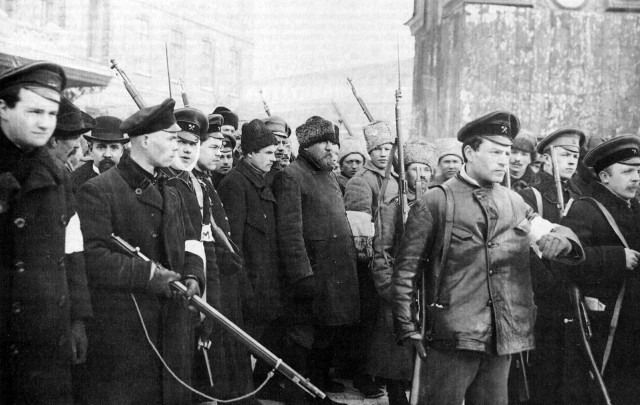
Having been forced to approve of the February overthrow of the Tsar, this revolution is declared ‘peaceful’ by the liberals. The reality is that approximately 1500 people died in February 1917. Most of these were unarmed workers shot down by the regime’s gendarmes, but you can be sure that as the general strike and revolt progressed, these workers armed themselves and, together with mutineering soldiers, inflicted casualties on the other side. In the final days of the regime some of its worst torturers were undoubtedly strung up. Our liberal historians assure us this was all done peacefully.
If 1500 died in the ‘peaceful’ February Revolution, then surely far more died in the “violent” October revolution? The reality is that almost nobody died in the seizure of the Winter Palace that swept up the remnants of the Provisional Government.
Many will have seen the classic Sergei Eisenstein movie about the Russian Revolution, October. The scene in the movie depicting the seizure of the Winter Palace is very exciting; with people running around shooting guns, throwing bombs, falling down and so forth. This scene bears no relation to the actual event, which was more of a police operation. Sadly, there were some lighting accidents in the shooting of October and some members of the crew died. There were more people killed in a film depicting the storming of the Winter Palace than in the actual storming of the Winter Palace!
This event brought Russia out of the war and precipitated the end of the First World War, thereby saving thousands, if not millions. The irony is that those who abhor the ‘violence’ of revolution are often those supporting the violence of war as just and necessary. The Russian workers were sick of the hypocrisy of such people, who only support war for the furtherance of war profits, and the workers were willing to make sacrifices to achieve a just peace without annexations. That is the justification for October, February, and revolution in general. When the majority has decided to make a change, and the minority resists by violent means, the majority has every right to defend itself.
Secondly, while February is labelled a glorious revolution with majority support, October is labelled an illegal coup by a small minority. Let us examine this contention. There are two definitions of coup in the political dictionary. One defines a coup as seizure of power by a minority, usually the military, with the consolidation of a regime without the consent of the mass of the population. The other definition is an “illegal” transfer of power violating the constitution of a given state.
Were the Bolsheviks in the minority? This is not seriously asserted by any primary source after September 1917. It is fully recognized that the overwhelming majority of the urban population supported the Bolsheviks in October. In the countryside, those who did not support the Bolsheviks supported the left Social Revolutionaries who were in favour of all power to the Soviets. The All Russia Congress of Soviets, the only genuinely democratically elected body in the country, returned a decisive majority for Soviet power and a coalition Bolshevik-Left SR government that would give land to the peasants, end the war, and grant self-determination to the oppressed nationalities.
The final proof of the majority support for the Soviets was the victory in the Civil War. The Tsarist army was smashed and the young workers’ state had to build an army from nothing. The Whites had the support of most of the old generals and twenty one armies of foreign intervention. Trotsky took on the near impossible task of building the Red Army. However persuasive Trotsky might have been, even he could not conjure up the human beings willing to fight, to supply, and to feed an army if it was politically unpopular.
The peasantry were willing to donate grain to feed the Red Army because that was the army stopping the landowner from returning and seizing their land. The workers volunteered to fight, die, and make munitions for the Red Army in order to stop the return of the bosses and imperialists. War is the continuation of politics by other means, and by this metric the Soviets were able to mobilize the majority to a decisive victory.
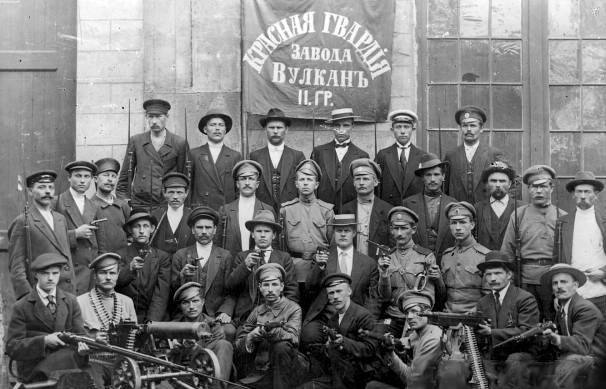
Perhaps the Bolsheviks did have majority support, but this doesn’t matter because they acted illegally and unconstitutionally? Even by this narrow juridical criteria the argument falls down. As explained above, there was no ‘constitutional’ way to remove the monarchy and install a democratic system. The only option was revolution. But what was the nature of the regime that emerged out of February?
The people doing the fighting and dying to overthrow the Romanovs were predominantly the workers in the major cities who convinced the soldiers to join them or remain neutral. These workers and soldiers organized themselves in soviets. ‘Soviet’ is just the Russian word for council, and each workplace elected a representative to this body according to fixed proportions. Military units, made up mostly of peasants in uniform, also elected delegates. Delegates were open to immediate recall. The Soviets were the democratically elected bodies that had the confidence of the mass of workers and peasants that actually fought to bring down the old regime in February.
Looking aghast at the movement below were the Liberals and Conservatives of the Tsarist Duma. This body was fantastically undemocratic in its formation, and had only consultative powers under the Tsar. Voters participated in ‘curiae’ of different social castes so that there was an inbuilt majority for landowners, capitalists, and nobility. The vote of 1 landowner would be functionally equivalent to the votes of tens or hundreds of thousands of workers and peasants in a country of 160 million. The Duma leaders did everything in their power to save the Tsar from the mass uprising of the people who looked to the Soviets.
In the dying days of the monarchy these unrepresentative individuals, mostly wealthy aristocrats, businessmen, and professors, declared themselves “The Provisional Government” despite having no democratic mandate – or constitutional basis – whatsoever. The masses who actually participated in the revolution were sceptical, but unfortunately the Soviets had elected reformist leaders, who gave their support to the bourgeois Liberals. The only democratic mandate of the Provisional Government was that leant to it by the reformist Menshevik and Social Revolutionary Party leaders of the Soviets. The masses didn’t support the Provisional Government, but at the start of 1917 they had faith in the Soviet leaders. Thus began the period of dual power, with the Provisional Government sharing power with the soviet executive. This was the ‘legal’ set up installed by the February revolution.
On 7-9 November 1917, the All Russia Congress of Soviets met in Saint Petersburg. 649 delegates were elected to the Congress, representing 318 local soviets from all parts of Russia. The Bolsheviks gained 390 delegates, and the left SRs 100, creating a decisive majority for withdrawing the mandate for the Provisional Government and declaring all power to the Soviets, the only democratically representative bodies in all of Russia. Therefore, even under the narrow confines of legality and constitutionality, the October revolution passes the test. By any definition, October was not a coup.
3) Without Lenin, Russia would have become a liberal democracy
If only it wasn’t for Lenin, Russia after February would have progressed into a nice, peaceful, democratic, liberal democracy following the model of France or Britain. Here we have another self-serving counterfactual myth that bears no relation to reality.
The first Provisional Government put the Liberal Kadets into power. If people had wanted liberalism this government would have remained stable. But the liberals could not give the people what they wanted, namely: an end to the war, land to the peasants, freedom for the oppressed nationalities, and food for the cities. All this was summed up in the Bolshevik slogan of “Peace, Land, and Bread”.
Due to its inability to solve the crisis in society this government fell and was replaced with a coalition government between reformist socialists and liberals. In turn, the bourgeois liberals were discredited and were replaced by a government almost entirely made up of reformist socialists from the Soviets, with Kerensky at its head. The reformists did everything in their power not to break with the capitalist order of things, but consequently they could not provide the people with peace, land, or bread.
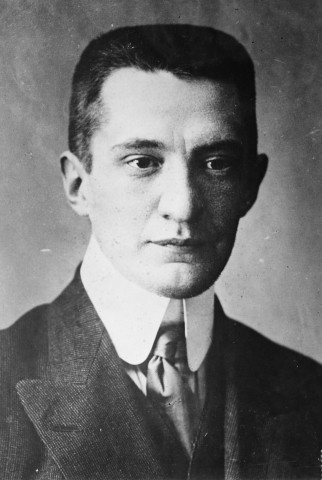
Despite Kerensky being a member of the Social Revolutionary party, traditionally based on the peasants, they did not enact a single word of the SR’s policy on land reform. They could not even convene a constituent assembly to write a democratic constitution, for fear not being able to control such a body. Step-by-step, mass support was moving to the Bolsheviks who called for a break with capitalism and all power to the Soviets.
The ruling class, the landlords and capitalists, could no longer rely on parliamentary maneuvers to maintain their power. All their parties had been rejected by the people. They instead moved to the methods of a fascist coup led by General Kornilov in August of 1917. Kornilov was not just going to massacre the Soviet workers, he would also have broken up the Provisional Government. Kerensky, rightfully fearing for his own head, released Bolshevik prisoners who in turn defeated Kornilov’s coup by mobilising the Petrograd workers and conducting agitation amongst the troops.
From that point onwards the ‘liberal, reformist’ Provisional Government was suspended in mid-air. The mass of workers and peasants looked to the Soviets to solve their problems. The bosses, landowners, and monarchists looked to Kornilovite reaction to teach the people a bloody lesson for being so impudent. The ‘middle-road’ had been tried and rejected by all sides. The only options were socialism or fascism.
But didn’t the Bolsheviks lose the vote for the constituent assembly? It is true that after almost a year of the liberals and reformists refusing to call the constituent assembly that it was actually the Bolshevik-led Soviets that organized this election. The results were 41 percent for the SRs, 24 percent Bolshevik, under-5 percent Kadet, and 3 percent Menshevik. It is notable to compare the vote of the Bolsheviks with the Kadets, the party siding with Kornilov’s generals and the White reaction. The Bolsheviks also gained decisive majorities in the urban centres and two-thirds of the vote amongst the soldiers of the western front.
Unfortunately, the split between the left-SRs, who supported Soviet power, and the right SRs had not been formalized at the time of the assembly elections. Therefore, the right SRs were significantly overrepresented in the party lists and the peasants were not given a genuine choice. The countryside voted SR while all the active sectors of society had moved far past the stage of arms-length parliamentarianism as seen in the imperialist countries. The Soviet system, where elections are direct, delegates are recallable, and there is no division between legislative and executive (i.e., every delegate has a job to do), is far more democratic than the parliamentary system where unaccountable MPs abandon their constituents for years at a time while raking in huge salaries.
When the constituent assembly met on 18 January 1918 it was a sickly hybrid anomaly. The reformists attempted to organize a demonstration in support but few attended. Delegates brought candles and sandwiches in case the power was cut off. At 4am the head of the guard, an anarchist, said, “The guard is tired. I propose that you close the meeting and let everybody go home”. And that was the end of the assembly that nobody was willing to fight for. It was not democratic enough for the workers, who looked to soviet democracy, and too democratic for the capitalist generals, who were preparing to launch the civil war to re-install some form of autocracy.
4) The Bolsheviks committed atrocities in the civil war
War is hell. Two sides attempt to defeat each other by violent means. Civil war is worse. The victorious side gains all, and the losing side loses all. If one side has a monopoly on violence, even if it only has the support of a minority of the population, it can terrorize the majority into submission. The violence of the minority has to be met with defensive violence of the majority if despotism is to be defeated.
The fact remains that anybody conducting a conscientious study of the Russian Civil War will find that the overwhelming preponderance of atrocities were to be found on the sides of the Whites and the 21 armies of foreign intervention.

In the early days, the revolution was in fact too kind-hearted and naïve. The Bolsheviks repeatedly showed magnanimity and let known active counterrevolutionaries go. This is understandable. The victorious revolution seeks unity and wants to move ahead with changing society in peace. Both Lenin and Trotsky said that many lives could have been saved if the revolution had acted more severely and resolutely from the earliest days, and this is undoubtedly true.
The revolution only began to adopt sterner measures in the face of atrocities committed by the counterrevolutionary Whites. The class struggle had broken the formal limits of democracy. The Whites had long ago given up any democratic or peaceful pretense, were using any methods they could – abuse, terror, massacres, pogroms, an orgy of violence – in order to defeat the Reds.
If they really wanted to defend themselves, the Reds had to drop their utopian ideas about peace and employ similar methods. Trotsky explained:
“It would not be difficult to show, day by day through the history of the civil war, that all the severe measures of the Soviet Government were forced upon it as measures of revolutionary self-defense. We shall not here enter into details. But, to give though it be but a partial criterion for valuing the conditions of the struggle, let us remind the reader that, at the moment when the White Guards, in company with their Anglo-French allies, shoot every Communist without exception who falls into their hands, the Red Army spares all prisoners without exception, including even officers of high rank.”
Trotsky would later go on to explain:
“The question of the form of repression, or of its degree, of course, is not one of ‘principle.’ It is a question of expediency. In a revolutionary period, the party which has been thrown from power, which does not reconcile itself with the stability of the ruling class, and which proves this by its desperate struggle against the latter, cannot be terrorized by the threat of imprisonment, as it does not believe in its duration. It is just this simple but decisive fact that explains the widespread recourse to shooting in a civil war.”
In one early atrocity committed by the counterrevolution, the Whites filled three freight cars with the bodies of Red Guards, their frozen corpses “placed in obscene positions” and returned them to starving enemies marked “fresh meat: destination Petrograd”.
The Whites were famous for their abuse of Bolsheviks and Red Army prisoners, or anyone suspected of being a Communist or Soviet sympathiser. A favourite punishment for captured revolutionaries was to mutilate them, gouge their eyes out and remove their tongues before burying them alive.
Denikin’s armies were famous for their pogroms and the orgy of looting, raping and pillaging they unleashed in the areas they occupied. It is estimated that hundreds of thousands of people were killed in this way.
The reader is under no obligation to take our word for it. The American Ambassador at the time, hardly a Soviet sympathizer, stated:
“All over (White held) Siberia… there is an orgy of arrest without charges, of execution without even the pretense of trial, and confiscation without color of authority. Fear-panic has seized everyone. Men suspect each other and live in constant terror that some spy or enemy will cry ‘Bolshevik’ and condemn them to instant death”.
One of the Ataman’s allied with Kolchak and supported by Japanese troops was described by a staff physician as a man with a “diseased brain of a pervert and a megalomaniac affected with a thirst for human blood”.
US General Graves described the behaviour of White troops thus:
“Semyonov and Kalmykov’s soldiers, under the protection of Japanese troops, were roaming the countryside like wild animals, killing and robbing the people, and those murders could have been stopped any day Japan wished. If questions were asked about these brutal murders, the reply was that the people murdered were Bolsheviks and this explanation, apparently, satisfied the world. Conditions were represented as being horrible in Eastern Siberia, and that life was the cheapest thing there.”
It has been said that Kalmykov’s reign of terror drove many moderates to support the Bolsheviks.
Semyonov was even constructing primitive death camps. On 19 August 1919, Colonel Stephanov slaughtered 52 carloads of prisoners, and the following day he reported that he had killed 1600 people. These human slaughter yards continued to operate throughout much of the civil war. Graves wrote:
“I doubt if history will show any country in the world during the last 40 years where murder could be committed as safely and with less danger of punishment than in Siberia during the regime of Admiral Kolchak.”
Kolchak’s capital had dozens upon dozens of bodies hanging dead from telegraph poles, and freight-cars full of victims were slaughtered at execution fields all along the railway.
Finally, in writing about his experiences, General Graves had this to say about the White terror:
“There were horrible murders committed, but they were not committed by the Bolsheviks as the world believes. I am well on the side of safety when I say that the anti-Bolsheviks killed one hundred people in Eastern Siberia, to every one killed by the Bolsheviks.”
The Soviets had to defend themselves against these atrocities. In the middle of a Civil War, no government would allow armed opponents the freedom to organize, agitate, and publish newspapers in the rear of its armies.
No ruling class in history has ever given up its power and position in society without a fight. In the face of the fierce and depraved resistance of the counter-revolution, revolutions throughout the ages have been forced to adopt stern and repressive measures as a means of self-defence. This occurred in the English Revolution, the American Revolution, the French Revolution, the American Civil War, the Russian Civil War as well as in countless other places and times in history.
Mark Twain, in his A Connecticut Yankee in King Arthur’s Court, provided an excellent historical defence of revolutionary terror. Though referring to the Reign of Terror in the French Revolution, it fits perfectly with the Russian Revolution, and indeed as a defence of any Revolution:
“There were two ‘Reigns of Terror,’ if we would but remember it and consider it; the one wrought murder in hot passion, the other in heartless cold blood; the one lasted mere months, the other had lasted a thousand years; the one inflicted death upon ten thousand persons, the other upon a hundred millions; but our shudders are all for the “horrors” of the minor Terror, the momentary Terror, so to speak; whereas, what is the horror of swift death by the axe, compared with lifelong death from hunger, cold, insult, cruelty, and heartbreak? What is swift death by lightning compared with death by slow fire at the stake? A city cemetery could contain the coffins filled by that brief Terror which we have all been so diligently taught to shiver at and mourn over; but all France could hardly contain the coffins filled by that older and real Terror—that unspeakably bitter and awful Terror which none of us has been taught to see in its vastness or pity as it deserves.”
5) The Romanovs were killed in cold blood
Have you ever wondered why you know about the ‘murder’ of the Romanovs but you have probably never heard of the British summary execution of the 26 Soviet commissars in Baku at around the same time? Did you know about the 4600+ peaceful protesters gunned down in January 1905 while delivering a petition to the ‘little father’, Nicholas II? Did you know he was a member of the anti-Semitic Union of the Russian People, he funded it, patronized it, and wore its badge proudly?
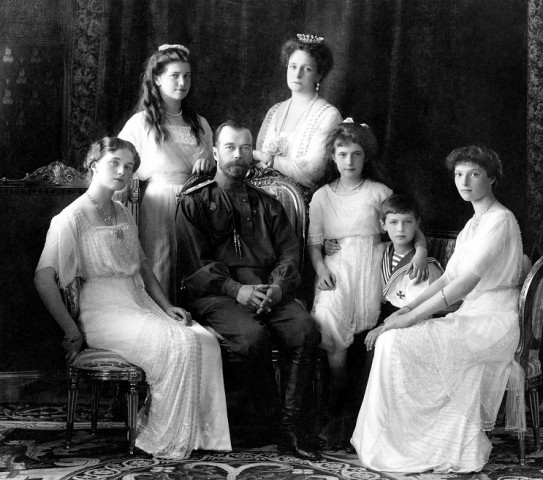
The Union was responsible for organizing murderous pogroms against the Jewish population with the assistance of the Tsar’s secret police and officers. Here rape, torture, burning, dismemberment, every horror imaginable, was inflicted on men, women, children, even infants. In one incident in Odessa 800 Jews were murdered, 5000 wounded, and 100,000 rendered homeless. The Tsar was not ignorant of these atrocities, in fact he wrote about them to his mother as the actions of “loyal people”! In another letter detailing the brutal repression of Baltic peasants, he said, “terror must be met with terror”. Thousands upon thousands of revolutionaries were executed under his regime or died in squalid prisons or Siberian exile. His final crime was ordering his troops to fire directly into the mass of protesters during the February Revolution. Yes, “Nicholas the bloody” had rightfully earned his moniker.
The attempt to present Nicholas as a quiet and humble man by the establishment represents the extremes of hypocrisy. Do they cry over King Charles I or Louis XVI, who brought the bourgeois to power? Do these people cry over the executions of Saddam Hussein, Bin Laden, Ceausescu, or other figures not friendly to the Western powers? Hillary Clinton was even recorded laughing over the death of Gaddafi. We don’t cry over these individuals either – but Nicholas was no better than any of them. But do they cry over the thousands of children killed by Bush and Blair’s bombs in Iraq and Afghanistan, or Obama’s drones in Pakistan? No, these victims are nameless and must be forgotten by the rich and powerful.
Some admit that Nicholas was a tyrant, but object to the execution of his family. Of course that was regrettable, but Nicholas did not pause to do the same to countless Jewish families under his own rule. Or to give a modern example, how is this different from a guided missile strike that kills two insurgents and 30 family members? Trotsky preferred a public trial that would detail the crimes of the Romanov Dynasty for all to see. But in the conditions of civil war that was not possible. In 1918 the Whites were closing in on the relatively comfortable house they were being held at in Yekaterinburg. If the White armies could get hold of any of the royal family it would have become a rallying point for the counter-revolutionary forces who did not hesitate to murder the families of captured revolutionaries.
This otherwise militarily insignificant area was suddenly the object of a White Army offensive that threatened the lives of thousands of poorly defended people. The Red Army did not have the resources to reinforce the area either. Thus, faced with the onslaught of the White Army, the Yekaterinburg Bolsheviks saw the execution of the Tsar’s family as the only way out of a bloodbath. In doing so they also removed what could have become a powerful figurehead for the counterrevolution to mobilise around.
They tell us that the killing of approximately 200,000 men, women, and children in the nuclear bombing of Hiroshima and Nagasaki was necessary because it ‘saved lives and shortened the war’. The reality is that the ending of the Romanov dynasty demoralized the Whites and saved lives by shortening the civil war.
What the capitalists object to is that instead of the imposition of violence by the rich against the poor, the oppressors against the oppressed, here we have an example where the slaves fought back and won. When the Romans defeated Spartacus’s revolt, they lined the Appian way with thousands of crucified slaves as a reminder to others.
Capitalism’s victims are nameless, and number in the millions. To quote Nicholas, sometimes, “terror must be met with terror”. The Bolshevik workers did not turn the other cheek, because they knew that there has never been a time that the meek inherited the earth. The violence of the poor majority to create a new world is essentially defensive and of far shorter duration than the violence of the rich minority to perpetually remain on their thrones. We do not seek violence, but we uphold the right of the majority to defend themselves against the violence of the minority by proportionate means.
